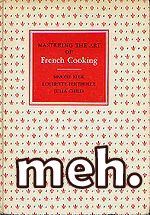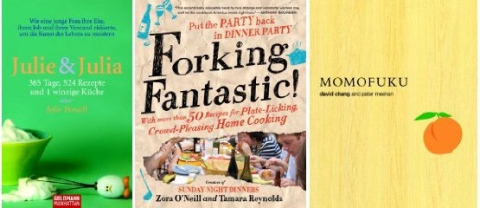 There, I said it. I really have never been at all swoony over Julia Child and Simone Beck’s Mastering the Art of French Cooking. I don’t typically bring it up in public, because then people shoot bloody daggers out of their eyes at you for speaking ill of Saint Julia, and they also then assume that you cook nothing but tuna-noodle casserole.
There, I said it. I really have never been at all swoony over Julia Child and Simone Beck’s Mastering the Art of French Cooking. I don’t typically bring it up in public, because then people shoot bloody daggers out of their eyes at you for speaking ill of Saint Julia, and they also then assume that you cook nothing but tuna-noodle casserole.
So let me be clear: Julia Child is perfectly delightful, and did a world of good for this country and its food culture. My father still speaks in hushed tones about the bad old days in the supermarket, when the only mushrooms you could buy were in a can. And I know and appreciate that the French have a fantabulous culinary heritage, and we should all learn to eat and drink in such a thoughtful way.
But MtAoFC is just not all that. I have never, ever flipped through it and thought, “Ooh, I’ll cook this.” In fact, I think the book has only served to reinforce my prejudice against French food, and how annoyingly special it seems to consider itself. Whenever I read a recipe in MtAoFC, I find myself thinking, “C’mon–really? Is all that shit necessary?” And you know I am not a dump-and-stir Rachael Ray type. I like spending time in the kitchen, and look for reasons to do so.
So it was interesting to read this little Julia Moskin book review in the New York Times today.
Moskin points out the fundamental problem with MtAoFC: it’s restaurant cooking. Child studied at a school for professional cooks (Le Cordon Bleu), and that’s what she relays in the book. As Moskin says, and I have said, restaurant cooking is wildly different from home cooking. Restaurant chefs prize consistency, perfectly velvety sauces and manically regularly cubed vegetables, and they have an army of people and gear to make that all happen.
Because of this, I have always been deeply skeptical of all restaurant cookbooks. But I guess I just don’t give enough of a crap about French food to ever have noticed that’s the same reason why MtAoFC rubs me the wrong way. I mean, sweet Christ, I have only peeled pearl onions once in my life, for a Greek stifadho, and I think that just might be enough.
And of course it’s great that the country is currently in the throes of Julia love, and people who’ve never cooked are inspired enough to march out to buy fatback and red wine and all that.
But how many people are going to get halfway through the boeuf bourguignon recipe, with every pot and pan dirty and no more counter space left and dinner still hours away, and say, “This is what cooking is?! Get me the hell out!” (Or, heaven forbid, they’ll cook the aspic.)
Moskin in the Times reviews a different French cookbook, I Know How to Cook, which focuses on home cooking skills. Totally hateful title, and ghastly chick-y cover, but even so: this one might finally get me on board with the whole French food thing.
Oh, and OK–I feel I should admit that in mine and Tamara’s forthcoming cookbook, there is a recipe for cassoulet, perhaps the pinnacle of ridiculous overrated Frenchiness. And the recipe references MtAoFC–which is, in fact, a very good reference…which is not the same as a very good book to cook out of. (I think we can safely say that whatever French business is in that book was Tamara’s idea.) But we worked hard to make sure the cassoulet isn’t just blindly following some overly complicated restaurant-y procedure. And as a result, I will probably never eat cassoulet again…
 Oh, wow. The Jamie Oliver episode was fantastic–and I’m not saying that because Tamara and I were in it. If anything, we were a little bit the weak link. The episode focused on immigrant culture and home-cooked food in Queens, and it made me so proud to live here, all over again.
Oh, wow. The Jamie Oliver episode was fantastic–and I’m not saying that because Tamara and I were in it. If anything, we were a little bit the weak link. The episode focused on immigrant culture and home-cooked food in Queens, and it made me so proud to live here, all over again.  So, as of this moment, I still have not seen
So, as of this moment, I still have not seen 
 There, I said it. I really have never been at all swoony over Julia Child and Simone Beck’s
There, I said it. I really have never been at all swoony over Julia Child and Simone Beck’s 








